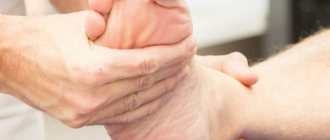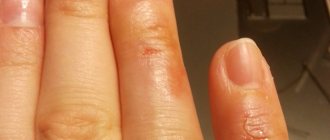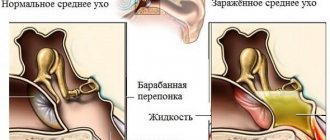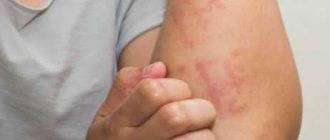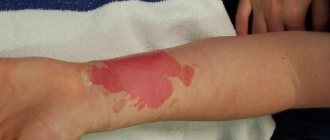Types of calluses
Wet callus
Appears due to mechanical action, friction of a hard surface against the skin. The first sign of a callus is tissue inflammation. A blister filled with lymphatic fluid then forms at the site of injury and is covered with a thin film of skin.
If there are closely located blood vessels, there is a high risk of rupture of one of them, then the lymphatic fluid mixes with the blood, and the callus acquires a characteristic color.
Doctors do not recommend opening the callus, as the film protects the deep layers of the skin from infection
If the callus breaks out spontaneously, it must be disinfected. With timely treatment at home, the wet callus becomes dry. The film fuses with the bottom of the callus as soon as the liquid dries up, and keratinized skin forms at the site of the wet injury on the leg.
Dry callus on the foot
Seals can be either thick or thin. Most often, the callus is located on the toes or on the side of the foot. It looks like a dense yellowish formation. Due to its structure, it can cause discomfort.
Corns
Formed as a result of wearing uncomfortable, pressing shoes. Corns should be classified as dry calluses. In places of pressure, the skin gradually thickens, and a rough skin formation appears. The formation process takes a long time, as the skin thickens layer by layer.
Often such calluses are located on the heels and lateral surface of the big toes.
It is very difficult to treat a callus on the feet such as a corn at home, since simply scraping off the keratinized skin does not have an effect and the thickening grows again
Callus with a core
It is a type of dry callus and the next stage in the development of corns.
The skin in the callus area roughens unevenly: in the center, a more massive thickening develops, which is why a semblance of a rod appears that goes into the deeper layers of the skin.
The rod can compress the nerve endings, then the callus becomes painful.
A callus whose root affects blood vessels is called vascular.
If the rod is located deep, independent removal is traumatic. You should contact the clinic to resort to cryodestruction or laser burning.
Fibrous
A dense formation that compresses the nerve endings. The pain is so severe that it is difficult for a person not only to wear any shoes, but even to walk barefoot.
Callus
This callus does not form on the skin, but on the bone. The prerequisites for the appearance of calluses are injuries and joint diseases. A type of callus is a heel spur. It occurs as a result of strong mechanical impact from shoes or due to joint disease.
It is necessary to distinguish calluses from warts, since not all pharmaceutical products and folk recipes help against both.
Prevention of dry calluses
It’s not often that we go to the doctor with callus problems. We prefer to treat ourselves. But if the callus is advanced and has deep roots, then it can be difficult to deal with it on your own. In this case, do not put off your visit to the doctor.
Modern medicine has a large arsenal of surgical treatment of calluses. Deep core calluses are difficult to remove on your own, but treatment with liquid nitrogen and laser is painless and effective. Do not endure pain and do not hesitate to consult a doctor.
And in conclusion, I would like to add that the best treatment for dry calluses on the foot is prevention. Do not allow formations on the legs, do not let the rough skin develop into calloused growths.
It is enough to follow the basic rules of personal hygiene - wear clean socks that fit, wash and clean your feet using pumice stones and other cleaning products. Take foot baths more often, steam and remove even small growths on the skin. Buy comfortable, high-quality shoes, and do not wear work shoes in everyday life.
Don’t forget to use special foot creams to prevent fungal diseases. In the summer, walk barefoot more often - this is not only an excellent massage, but also stimulates blood circulation.
You need to take care of your feet constantly, not just occasionally. Feet are our support; taking care of them is as natural as taking care of your hair, hands and face.
What to do if a callus bursts
It is not always possible to maintain the integrity of a wet callus. Often the film breaks on its own and the liquid flows out.
In this case, the main thing is to carry out disinfection in time, since an open, weeping wound is an excellent breeding ground for staphylococcal or streptococcal infections.
Treatment of a burst callus
Iodine, furatsilin solution, potassium permanganate, brilliant green, 70% alcohol, 2% hydrogen peroxide are suitable for the procedure.
The procedure is performed with thoroughly washed hands. The treated area also needs to be cleaned of dirt.
It is necessary to lubricate the damaged area so that the product does not get directly into the wound, as this will slow down tissue healing.
A bactericidal or anti-callus patch is glued to the treated area. It protects the wound from bacteria and absorbs remaining lymphatic fluid.
If you follow another method, you need to lubricate the callus with salicylic ointment or pine resin and apply a sterile bandage.
Is it possible to pierce
If a wet callus is large in size and located in a place that is subject to mechanical stress, it causes serious inconvenience.
In this case, it can be pierced, but you must follow several rules:
- Hands must be washed thoroughly with soap; you can additionally use antibacterial gel.
- The puncture is made with a disinfected needle. To disinfect the instrument, it is calcined over a fire or washed in alcohol. Disinfection should take place within a few minutes.
- The area of damage is also disinfected by wiping with an alcohol solution, iodine or brilliant green.
- The puncture is carefully made, holding the needle almost parallel to the skin. It is important not to touch the bottom of the callus with the tool, as this will lead to serious inflammation.
- To enhance the outflow of liquid, you need to make several punctures, but so that the skin does not break completely. The surface must be relatively intact so that it can protect the delicate skin from infection.
- Then a sterile napkin is applied to the callus and the callus is pressed. The liquid will leak out and the top skin will stick to the bottom of the callus.
- Antibiotic ointment is applied to the wound, then the damaged area is covered with a band-aid. The patch must be changed 2 times a day and removed at night. When exposed to air, the callus will dry out faster.
Signs of wet callus infection
In the absence of proper treatment at home, a broken callus on the foot can easily become infected, since the loose, delicate skin located under the upper film of a wet callus is a suitable environment for the spread of infection. However, the infection penetrates not only into an open wound, but also into a closed one.
General signs of infection are as follows:
- Nearby tissues become inflamed and red.
- The damaged area is very painful.
- Lymphatic fluid becomes cloudy.
- Purulent contents are released.
- The callus area becomes covered with yellow crusts.
- Body temperature rises.
It is necessary to open the callus on the foot, if infection does occur, remove the skin covering the internal space, disinfect it, apply antibacterial ointment, and cover with a sterile bandage. Treatment at home is not continued if the condition worsens, but consult a doctor, since in such cases drug treatment is required.
Don't miss the most popular article in the section: Morning exercises for those over 40, 50. Gymnastics exercises for weight loss, video lessons.
How to get rid of water blisters
Treatment of calluses should be carried out based on the degree of their neglect and type of formation. The situation is easiest with dropsy, because... they can be classified as “fresh”.
It should be noted right away that opening calluses on your own is risky - you can get an infection. But if you are sure that you will do everything correctly, then strictly adhere to the rules of hygiene.
- The dropsy and the area around it are washed with soap. Hands must also be disinfected.
- Take a sterile disposable syringe needle (new, unused).
- A wet callus is opened in the place where the skin has separated from the tissue. The puncture should be small.
- Do not try to squeeze liquid out from under the skin.
- Remove what came out of the dropsy during a puncture with a cotton swab moistened with hydrogen peroxide.
- The same antiseptic (or alcohol) should be used to treat the opened callus.
- The skin at the site of the dropsy should not be cut - it will serve as a protective “lid” for the wound.
A sterile bandage is applied to the area treated with an antiseptic. If the wet callus is large enough, apply a gauze pad. For a small wound, a bactericidal adhesive plaster will be sufficient.
You shouldn’t keep a water callus “packed” for a long time - the skin needs to breathe for rapid healing. Therefore, during sleep, the problem area can be left open. Pain and burning in the area of the blister can be relieved by placing a cotton wool soaked in milk (cold) on the callus.
Treatment of calluses
How to treat a callus on the foot
Corns often form on the feet. A course of steaming baths with soda and soap will help soften rough skin.
A bath with soda is done before removing dry calluses or corns on the feet. It is also present in almost all procedures for the treatment and removal of calluses at home.
For 1 liter of water at a temperature of about 40-45 degrees, take 1 tbsp. soda and a little soap. Dissolve the components in water and immerse your feet in water for half an hour. After steaming, your feet should be treated with pumice. It is recommended to do such baths every day for a week.
After the bath, apply compresses prepared according to folk recipes, for example, based on raw potatoes or bread crumbs. They will be discussed in detail below.
How to treat a callus on your toe
Calluses on the toe are caused by wearing uncomfortable shoes, especially pumps, because the pressure of the body's weight is placed directly on the toes. During treatment you should avoid wearing such shoes. A salicylic acid patch is an excellent remedy for calluses on the finger.
Sequence of callus treatment:
- First, the feet are steamed in a soap and soda bath.
- After steaming, a salicylic patch is glued to the damaged skin and worn for 2 days.
- After removing the patch, the callus will soften. All that remains is to clean it off with a pumice stone and lubricate the skin with moisturizer.
Treatment of calluses on the heel
In this area, calluses can be either wet or dry formations, often of a core type. It is recommended to use a compress of anti-corn ointment.
Sequence of callus treatment:
- The callus area needs to be disinfected.
- Then they take a regular adhesive plaster, cut a hole in it so that the areas around the callus are covered with the plaster, and the callus itself remains open.
- Glue the patch in place.
- Apply ointment for calluses to the skin.
- A larger piece of adhesive tape is glued on top.
You should wear the compress for 1-2 days, after which the callus will soften so much that it will peel off on its own.
Causes of calluses
Most often, people encounter rubbed calluses. The reason for their appearance is the wrong choice of shoes. This problem affects women to a greater extent. Representatives of the fairer sex are often fond of beautiful, but not very comfortable shoes. Rubbed callus appears when wearing tight shoes and ballet flats. This does not mean that such shoes cannot be worn. However, you should give preference to quality materials. Shoes with the correct last made of soft leather will not damage the skin of your feet. Hard materials contribute to the appearance of calluses. In addition, it is worth choosing shoes, paying attention to the size. It must fit not only in length, but also in width. Narrow and tight shoes put pressure on the skin of the feet, which contributes to the development of calluses and foot deformities.
Other causes of the pathology include: excessive sweating of the feet, abnormal gait and obesity. Excess weight leads to increased stress on the lower limbs. This causes flat feet and abnormal gait. Due to the increase in the transverse size of the feet, calluses appear on the lateral surfaces of the toes. In addition, damage to the skin of the feet occurs due to friction against the seams of hosiery. Therefore, when calluses appear, you should pay attention to the choice of socks and tights. They should match the size of the foot and have soft, not very pronounced seams.
Another group of causes of calluses is skin diseases. Constant dryness of the feet and excessive keratinization of the epidermis lead to the development of corns. Skin diseases of this spectrum include: psoriasis, vitamin A deficiency, vascular pathologies and diabetes mellitus.
Callus patches
Any patch protects the damaged area from infection and reduces pain due to mechanical impact. But for dry and wet calluses, you should choose different patches, since some patches are more effective in treating dry calluses, while others are more effective in treating wet calluses.
Compid
There are several types of patches on sale: for wet, dry, ingrown calluses. The patch pieces are placed in a convenient box.
According to reviews, the patch always copes with its task, speeds up healing, and gets rid of corns. In addition, the material of the patch is translucent, so it is almost invisible on the leg.
Plasters of different shapes, according to the location of the callus. The manufacturer prohibits cutting them. This is convenient if you buy a patch separately for each case, but if the calluses are located in different places, you will have to buy different packages. The disadvantage of this product is its significant cost: more than 200 rubles for 5 pieces.
Salipod
A good remedy for getting rid of old dry calluses. It contains salicylic acid, which softens dead skin.
The patch is glued on after a steam bath, secured with an adhesive plaster included in the kit, and worn for two days.
The patch does not always stay on the skin for two days. If it comes off and the effect is not achieved, it should be replaced. Under the influence of the active substance, the callus turns white and peels off. The price of the patch is about 60 rubles.
Silkoplast
offers patches of different shapes in one package.
This:
- universal moisture-resistant bactericidal patches impregnated with silver ions;
- specialized anti-callus products (hydrocolloid) for wet calluses, which are similar to similar products from the Compid brand.
The hydrocolloid patch absorbs lymph fluid, turning it into a gel. The moist environment created by the patch promotes healing.
The package contains 6 patches. The price is 300 rubles. It is convenient to stick bactericidal patches on a callus if there are no other means at hand. The package contains several patches of different shapes. They disinfect the wound thanks to silver ions. The cost of packaging is 100 rubles.
Scholl
The patch is a silicone pad with adhesive edges around it that are completely transparent. The patch is expensive (more than 300 rubles).
Reviews are contradictory: for some, it helps heal bleeding calluses and does not come off for several days even with daily showers; others say that it does not adhere well to the skin.
Don't miss the most popular article in the section: Laser hair removal on the face and body - how it is done, effectiveness, before and after photos, contraindications.
How to get rid of calluses
Bone calluses have nothing in common with ordinary growths. They have different reasons for their formation, different structures. Therefore, treatment methods will differ.
Since callus is formed from bone tissue (and not in layers of skin), methods for removing it that are applied to ordinary calluses will not work here. Removal of such formations is carried out surgically, which means that self-medication in this case is completely excluded.
But surgical removal of bone calluses is also carried out if they cause inconvenience (and not only of a cosmetic nature). The main reasons why surgery is suggested are: pain caused by a callus, or unwanted deformation at the site of a healing fracture.
Creams and ointments for calluses
Creams and ointments for calluses are easy to use, but you need to apply them carefully, since the active ingredients included in the composition cause irritation to healthy skin. The product is applied directly to the callus itself, and the surrounding tissue is protected with adhesive tape or Vaseline.
Among the components of anti-callus creams and ointments are: salicylic and benzoic acid, urea, lactic acid, vitamin A and E, tea tree oil, aloe extract and others. Before using the cream, you need to steam the skin of your feet using a bath of soda. Then the effect will be more noticeable.
Bensalitin
The composition contains both salicylic and benzoic acids. The ointment is intended for the treatment of corns. She softens them. It should be applied to the affected area, having previously lubricated the surrounding tissues with Vaseline to protect them from the effects of the active substance. Then a patch is glued on top. Costs 60 rubles.
Super Antimozolin
A product based on urea and lactic acid. Has a softening effect.
The drug is applied to cleansed skin, after which the area should be covered with a film and sealed with a band-aid. After some time, the dead skin can be removed with a cosmetic spatula. Price – 90 rubles.
Pasta “5 days”
Contains petrolatum, lanolin, salicylic acid.
It is necessary to apply the product to steamed skin for 12 hours. After this, the callus should separate from the healthy skin. If this does not happen, the procedure is repeated again.
Salicylic ointment
This is the most inexpensive remedy (only 30 rubles) that effectively fights old calluses. It helps with both dry and wet calluses. The ointment dries wet calluses, softens dry calluses. Has a healing effect. This remedy is also suitable for removing warts.
Callus
The ointment helps with corns. This product is in the same price category as salicylic ointment.
Reviews are contradictory. Not everyone likes the method of application: you need to stick a patch with a slot on the callus, then apply ointment and seal the slot on top.
It is inconvenient to wear a compress on your leg for 2 days, as required by the instructions, especially in the summer. But those who follow the instructions are satisfied with the product. It fully copes with its tasks.
Cream "Stoletnik"
The cream contains many plant components: extracts, essential oils, and also contains salicylic acid and petroleum jelly.
The cream helps especially well after a course of steaming baths, followed by treatment with pumice stone and application of the cream. Price – 80 rubles.
Bottega Verde
Sold in a 50 ml jar, for which you need to pay more than 300 rubles. Made in Italy. According to reviews, this is one of the best creams that helps get rid of advanced calluses on the feet in a week thanks to its 25% urea content.
Of the minuses: the product takes a long time to absorb, so it is recommended to apply it at night.
Cream "Green Pharmacy"
The cream is not bad. But to achieve significant results, you should use it systematically. This is a skincare moisturizer that is not suitable for emergency use. Price – 60 rubles.
Dry callus on the sole of the foot - how to cure it
You can get rid of it in a clinic or specialized salon. For example, grinding can be done using a laser beam. And with the help of liquid nitrogen, the dead cells that make up the callus are frozen out.
Sometimes you can only use traditional methods or cosmetics. But in many cases this is not enough; medical help is needed.
With the help of the necessary equipment, keratinization on the soles can be quickly eliminated. Stages: steaming the skin, intense scrub, properly massaged, polishing and removal.
Keratolytic agents are popular. They can be bought at any pharmacy without a doctor's prescription. The abundance of such funds is amazing, it’s difficult to choose just one. The basis for the keratolytic agent is salicylic acid.
It removes the roughened layer of the epidermis and has an antiseptic effect. But in addition to salicylic acid, there will also be such components: lanolin, herbal extracts, petroleum jelly.
Keratolytic agents are available in the form of creams and ointments. They need to be applied locally to the damaged area. Use gloves when applying. The product must not come into contact with healthy skin, especially the mucous membrane.
Benefits of ointments and creams:
- The composition is based on natural ingredients;
- The first result is noticeable quickly;
- Treatment can be carried out independently;
- Low price.
Disadvantages of ointments and creams:
- The effect is only from constant use;
- Poor effect on healthy skin;
- There is a high risk of allergies.
Pencils are a convenient tool. You can take it with you. If the shoes are new, a pencil really helps! This is an excellent prevention of calluses.
Traditional methods
Folk remedies prepared at home help with wet calluses on the feet and corns, but are ineffective in treating core formations, since the compositions are not so aggressive as to affect the deep layers of the skin.
If calluses appear on your feet, how to treat wet and dry formations at home, the following recipes will tell you:
- 1 onion and raw potato should be chopped using a grater or blender. Then the ingredients are mixed, placed on one half of gauze, folded in half, and covered with the other half. Apply to the callus overnight, securing the bandage with a bandage.
- The feet are steamed in a hot bath with soda and soap. Propolis is heated in the palms, kneaded, then applied to the callus and sealed with a band-aid. After 3 days, the old patch is peeled off and replaced with a new propolis patch. Glue it again onto the steamed skin.
- A crumb of bread soaked in acetic acid will help with dry calluses. First you need to roll it into a tight ball, then moisten it in vinegar and apply it to the callus. Mild burning and redness are a normal reaction. After a few hours, the rough layers of skin will begin to peel off.
- A leaf of aloe, Kalanchoe or money tree needs to be peeled from the top layer and applied to the callus, fixed for several hours. For convenience, it is optimal to apply such a compress at night. The procedure can be repeated until the callus completely disappears.
- For wet and dry calluses, use a compress prepared from a mixture of fish oil and aloe juice in equal proportions. The ingredients are mixed and left for half an hour. Then soak a cotton pad in the composition and apply it to the sore spot. Cover the top with a bandage and leave overnight. In the morning you need to wipe your skin with chamomile decoction. It will cleanse the skin of homemade ointment and have an additional antiseptic effect.
- An infusion of garlic and onion peels in vinegar allows you to quickly get rid of both dry and wet calluses. 5 heads of garlic, without peeling, need to be poured into a jar, peeled from 5 large onions, added to the garlic and poured with vinegar so that all ingredients are immersed in the liquid. Then the jar is closed and left to infuse in a dark place for 2 weeks. Then they take out the husk and apply it to the calluses overnight.
- A compress made from grated tomato is also successfully used due to the acid it contains. It is necessary to chop the sour tomato, apply it to the callus, and cover it with a bandage. The product is used daily until the callus disappears.
- Apply lemon zest to the corns with the yellow side, after steaming the skin and making several cuts on the peel. You need to keep the compress for 2 days, and after another two days repeat the procedure.
- It is easy to get rid of calluses if you systematically lubricate the calluses with the juice of a freshly cut celandine stem. The callus will go away in 2-3 weeks. A more advanced recipe: mix 1 part plant juice and 4 parts Vaseline. The composition should be used before bedtime as an ointment.
- Prunes need to be boiled in milk and, while they are still hot, applied to the callus. The compress is replaced with a new one as it cools. The duration of the procedure is 30 minutes.
- Baths with calendula and chamomile will help disinfect and soften rough skin. 1 tbsp. plant mixtures are brewed with 1 tbsp. boiling water Infuse the composition for half an hour, then add it to a basin of water prepared for a foot bath.
- Old calluses on the feet can be treated with an apple cider vinegar bath. Add 2-3 tbsp to hot water (so your feet can tolerate it). apple cider vinegar (you can use homemade apple cider vinegar). Steam your feet, and as soon as the water has cooled, scrape the softened skin with a pumice stone. Lubricate the rough areas with salicylic ointment and put on socks. The course of procedures is daily for 1-2 weeks.
To achieve the best result, it is recommended to combine pharmaceutical and folk remedies and not stop treatment until a lasting effect is achieved
It is necessary to objectively assess the complexity of the problem and consult a doctor if there is no improvement or an inflammatory process is observed.
Surgical removal of calluses
In some cases, quite deep, ossified calluses appear. They not only cause severe pain, but also damage healthy tissue. Such formations include a callus on the heel. What to do if you can’t remove the rod yourself? In such cases, you should consult a doctor. Unfortunately, deep calluses and heel spurs can only be removed surgically. Alternative treatment methods are laser therapy and cryodestruction. In the first case, the callus is exposed to a strong light flux. Cryodestruction is the removal of the callus core using liquid nitrogen, which freezes the pathological area.
The traditional surgical method is to surgically remove the ossified area. The root is gradually drilled out of the heel using a special apparatus. Such treatment requires rehabilitation.
Home remedy for calluses and corns - my experience
At home, pumice stone and apple cider vinegar will help remove the painful lump. It is not so easy to remove hard calluses with a stick. To do this, you will need a course of foot baths. You can speed up the process if you add oils and products with urea.
Baths
To eliminate a small chafing, you will need 2-3 procedures, and to remove an old callus – about 10 sessions. Continue until the skin is soft.
Execution order:
- Steam your feet in a soap and soda solution for 20–30 minutes. Water temperature – 40 or a little more.
- When the stratum corneum softens, treat the seal with pumice.
- Lubricate your feet with moisturizer.
Castor oil is suitable for treating skin inflammation. It softens, accelerates healing, and helps remove rough calluses on the fingers and feet. To get the effect, rub the oil into clean skin of your feet for a week. Repeat the course after a three-day break.
Tea tree oil is no less useful. A natural antiseptic that copes well with any infection.
Add 4-5 drops to warm water and take a foot bath for 15 minutes. No longer worth it - tea tree oil is highly concentrated and sometimes corrodes the skin.
Apple vinegar
This product softens the stratum corneum due to a large amount of acid. To reduce a callus:
- Add a glass of vinegar to a liter of warm water and soak your feet in the solution for 20–30 minutes.
- When the thickening softens, treat the surface with pumice or a special file.
- Apply moisturizer and wear cotton socks.
This porous material does a good job of removing rough skin and corns. During foot treatment, blood flow improves and healing accelerates.
Massage with pumice stone on steamed skin.
Movements should be intense, but not painful. Carry out the procedure 3-4 times a week. More often it is impossible - the development of an inflammatory process is possible.
The product acts as a skin softener and peeling. Add baking soda to baths or use as a scrub. To enhance the effect, mix the powder with shower gel. Rub the resulting paste into rough skin. If the seal is too hard, use additional pumice. The effect is noticeable within two weeks.
Finding and eliminating the cause of calluses (for example, changing shoes, or taking special vitamins that can strengthen the skin, etc.)
Bandaging the damaged area, or using a special antibacterial patch.
Treatment for dropsy is quite simple and inexpensive.
Treatment of calluses should be done with an antiseptic solution. If removing a callus involves piercing it, it should be done with a clean needle. You cannot pierce the callus from above; the puncture should be made from the side, it is less painful and safer, because When making a puncture from above, there is a possibility that the callus will become inflamed because
What not to do with a callus:
- You cannot cut off the top layer of callus yourself with a knife or other means. The peel is needed to prevent germs and infections from entering the wound.
- It is not advisable to use an adhesive plaster on a swollen, unbroken callus.
Treatment for calluses may not be necessary if they are prevented from occurring. To prevent the appearance of calluses, you should follow a number of simple rules:
- Selecting the right socks and shoes; don’t take shoes a size smaller in the hope that they will stretch over your feet. Breaking in shoes before wearing them is of great importance.
- In warm or hot weather, you should wear shoes that allow your feet to “breathe” and not sweat.
- It is worth carrying plasters with you, if you feel discomfort or rubbing, immediately save a possible area for a future callus.
- Socks made from natural fabrics will significantly reduce the chance of blisters forming. You can use sports socks to wick away moisture.
- Use petroleum jelly and oils, take care of skin health.
- There are foods that contain vitamins that are beneficial for the skin, such as carrots.
- Avoid wearing heels or stilettos.
- Monitor excess weight and nutrition.
- Carefully maintain foot hygiene, thoroughly wash the inside of your shoes.
- You can use talcum powder by sprinkling it on areas where calluses often form. Your feet will sweat less.
- Visit a doctor in case of physiological characteristics of the legs.
- Correction of gait.
We suggest you read: The skin on the fingers is deteriorating
Wet calluses
Wet calluses are also called water calluses or soft calluses. They look like bubbles filled with colorless or yellowish lymph fluid. Despite the fact that this type of callus is accompanied by the most unpleasant sensations and acute pain, they are the easiest to get rid of without leaving a trace in the shortest possible time. They usually occur due to severe rubbing of the skin by unsuitable or new shoes.
In rare cases, if there are capillaries located close to the surface of the skin and they are damaged, the contents of the vesicle have a reddish color.
Dry calluses
The first stage of the formation of a dry callus is a corn - a slight swelling and redness of the skin. Over time, it hardens, loses sensitivity, becomes smooth or, conversely, rough to the touch, acquires a yellow or gray color, and can become covered with cracks of varying depths.
Dry calluses are formed when the load on the foot is unevenly distributed, most often at the base and on the balls of the toes due to systematic long-term pressure on the skin of the feet. These thickenings of the surface layer of the epidermis, consisting of dead cells due to impaired blood circulation, can cause a burning sensation and pain when walking.
Interesting: Corns in women are 10 times more common than in men, which is primarily due to prolonged wearing of high-heeled shoes.
Core calluses
Core calluses consist of a cap and a hard root (shaft), which penetrates into the deep layers of the skin and causes pain when pressing and walking. In appearance, they are a small bulge on the skin with a wound-like hole approximately in the center, where the rod is located. If the root is located near the nerve endings, then it can compress them, causing severe pain, depriving the person of the ability to fully stand on his leg.
Calluses occur as a result of constant mechanical impact on a certain area of the skin or damage to the skin by a virus that disrupts the normal process of periodic exfoliation of dead cells. Most often they are localized in the area of the big toe, little finger or in the interdigital spaces, as well as on the heel.
Folk remedies for getting rid of calluses include baths with herbal decoctions, sea salt and soda, masks and compresses with vegetable oils, medicinal plants, vegetable and fruit pulp. It may take a long time to get good results and complete disappearance of rough layers of skin.
To eliminate corns and dry calluses, you can use special products sold at the pharmacy. They are available in the form of a patch, solutions, creams or ointments. The main active ingredients of these drugs are salicylic and lactic acids, which have a pronounced keratolytic effect.
- Kollomak solution;
- "Salipod" patch;
- cream “Namozol”;
- "Compid" patch;
- liquid "Stopcorn";
- cream "Super Antimozolin" and others.
Important: When applying pharmaceutical products for calluses, you should strictly follow the instructions included with them and avoid getting them on healthy areas of the skin, as they cause inflammation and burns there.
If you do not want to use surgical methods, then traditional medicine also has a number of useful recipes that help get rid of different types of calluses.
Wet callus
If you do not want to pierce the callus with a needle, you can use the following recipes:
- Salt bath - pour a couple of tablespoons of salt into 2 liters of warm water, then soak your feet in it for about ten minutes. Be sure to rinse them to remove excess salt. Chamomile or milk baths will have a similar effect;
- Essential oil lotion – the composition of the product consists of vegetable and tea tree essential oils in a concentration of 3 to 1. Wet a cotton swab with the product and apply it to the callus. It is recommended to do this lotion at least 4 times a day, since tea tree oil, in addition to its healing effect, will have an antiseptic effect;
- Potato lotions - potatoes are grated on a fine grater, after which the pulp is spread on cheesecloth. A gauze swab is rolled into a bag and applied to the damaged area, after which it is fixed with a bandage or plaster. Change once a day;
- Lightly rub fresh plantain leaves in your hands, apply to the painful area and stick with a band-aid.
Dry appearance of calluses
Traditional methods act as additional treatment; they are especially useful for healing damaged skin.
Several effective recipes:
- Onion compress - put grated onion gruel on the place of the callus, wrap the leg in plastic and leave for the whole night. In the morning after removing the compress, walk over the area with a pumice stone;
- A fresh aloe leaf with oozing juice must be applied to the injured area and fixed. It is best to do the procedure at night so that the effect lasts for at least 8 hours;
- Tomato pulp - use a similar method, however, the compress should not be kept for more than 3 hours;
- Baths made from a decoction of pine buds or salt baths, a solution of potassium permanganate - steam your feet in them for no more than 15 minutes.
We invite you to familiarize yourself with Heel fungus: what it looks like (PHOTOS) and how to treat mycosis on the heels
Pharmacy products
Medicines are easy to use. They deal with the problem quickly and effectively.
Patch
The patch is used not only to prevent calluses, but also to treat them. To do this, you need to purchase patches with special impregnation.
They disinfect the damaged area, relieve pain, and soften the upper, keratinized layer. After use, the patch is removed along with the callus. The most popular products from this series: “Compid”, “Salipod”, “Urgo”.
Ointments and creams
The following drugs help in the fight against calluses:
- Vishnevsky ointment. It contains effective antibacterial components: castor oil, tar, xeroform. The product perfectly relieves inflammation and prevents suppuration. The ointment is applied at night as a compress. In the morning, the sore spot should be thoroughly washed with chamomile infusion and allowed to dry. The procedure is repeated until complete recovery;
- salicylic ointment. This is one of the most effective remedies for treating skin diseases. The main component of the ointment is salicylic acid. It has powerful disinfectant and exfoliating properties. Thanks to this, the skin quickly recovers;
- cream "Doctor". The composition of the cream allows you not only to fight calluses, but also to restore the moisture balance in the skin. The product is effective in treating wet, burst calluses. It disinfects the skin well and promotes its rapid healing;
- Nemozol ointment. Effectively eliminates dry calluses. After lubricating the problem area, it must be sealed with a bactericidal plaster and left for a day;
- Levomekol ointment. The drug disinfects and restores the skin, improves blood circulation in the damaged area.
Gels
They have a pleasant consistency. They are simple and convenient to use. The following drugs can be distinguished from this series:
- keratolytic gel. The main component is salicylic acid. It effectively disinfects and heals the skin. Additionally, the gel contains softening components: extracts of medicinal herbs, lanolin and petroleum jelly;
- cream-gel “Callus”. The product moisturizes, disinfects the skin, and promotes exfoliation of dead skin areas.
Pencil
The product protects skin prone to calluses. If a neoplasm appears, the pencil prevents its further development.
How to treat calluses at home, watch this video:
Acid
This component is included in many medications for calluses. But you can also use it as an independent remedy. To remove dead skin, use:
- salicylic acid;
- lactic acid;
- benzoic acid.
Serum
The drug has a gel-like consistency. The composition includes medicinal herbs, glycolic and salicylic acid, moisturizing components. The serum is applied to the skin, which is then wrapped in plastic film.
Exposure time is from 45 seconds to 25 minutes.
Potassium permangantsovka
The drug disinfects the skin. It can be used to treat broken calluses and also soften dry skin. In the latter case, night baths with the addition of potassium permanganate are used.
Zelenka
It is an effective antimicrobial and healing agent. Used to treat burst calluses.
Socks for calluses
They are made of natural fabric impregnated with antibacterial and moisturizing agents. To treat calluses, socks are worn throughout the night.
How to prevent calluses
- Choose the right shoes. The main criterion here is convenience. Your new shoes should feel comfortable right away. Don't listen to sellers who claim that shoes are worn out. Yes, it spreads, but it will result in calluses on your feet. Choose summer shoes in the evening, when your feet are slightly swollen. So, you can easily choose shoes that fit and you won’t have to worry about breaking them in.
- Prepare your shoes for long-term wear. Don't wear a new pair for the whole day. Wear it in gradually. Go shopping there several times, walk the dog, etc. To break in new shoes, you can stuff them with damp newsprint and leave them until the morning.
- Prepare your skin.
Calluses appear when the feet are very dry or, conversely, too wet. If your feet often sweat, dry them thoroughly every time you wear them. Use special deodorants for shoes. Baths made from medicinal herbs are great for coping with sweating: chamomile, calendula, mint. If the skin, on the contrary, is too dry and sensitive, lubricate it with a nourishing cream as often as possible.

